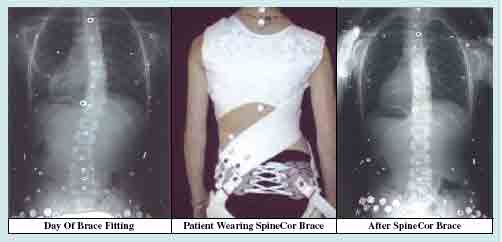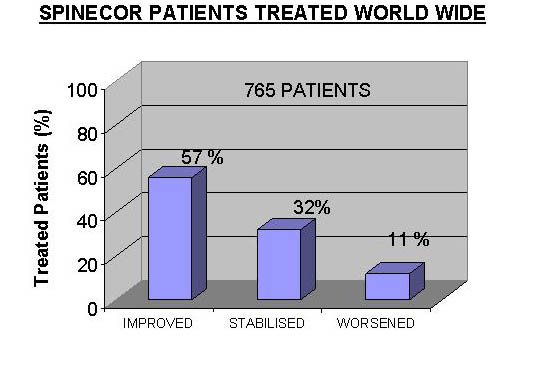
|
|||||||||
|
|||||||||



|
||||||||||||
|
Research


SpineCor Patient Treated Worldwide The SpineCor system is currently being used at Ste-Justine Hospital as well as 52 centres world wide with nearly 725 patients in-treatment as of April 2002. At the time of the last update of the latest available visit for these patients are presented in the above table, which demonstrates an improvement or stabilisation for 89% of the patients in treatment. Interim Results of a Prospective Randomised Study of the Natural History of Idiopathic Scoliosis VS Treatment with The SpineCor Brace The objective of this prospective randomised study was to compare the natural history of Idiopathic Scoliosis patients to those treated with a SpineCor brace with a Cobb angle between 15 and 30 degrees. A cohort of 65 patients were randomly assigned to a control non-treated (n=36; age=12 years; Cobb angle:20±5 degrees) or treated group with the SpineCor brace (n=29; age=12 years; Cobb angle : 22±5 degrees). Inclusion criteria included an initial Cobb angle between 15 and 30 degrees, Risser 0, 1 or 2, high risk of progression (increase of Cobb angle of 5 degrees or more within the last 6 months), girl or boy and no significant malformation of the spine. Each patient underwent a comprehensive evaluation (radiological and clinical) prior to commencing the study, at 4 month intervals during treatment and follow-up. From both groups there were 3 patients who withdrew. For the remaining 33 control subjects there was a mean Cobb angle of 26±8 degrees and for the treated group, 20 are still in treatment with a mean Cobb angle in brace of 15±7 degrees. The remaining 6 patients, in the treated group, have been weaned from the brace but for less than 1 year. Table 4: Percentage of Patients Improved, Stable and Worsened at the Last Available Visit
This is the first prospective randomised study on Scoliosis patients investigating the Cobb angle between 15 and 30 degrees. This interim evaluation reveals a strong tendency where 52 percent of the control group worsen, compared to the treated group who showed a worsening of only 5 percent. This interim result, which shows this large difference in worsening between treated and non-treated patients, questions the logic of continuing this prospective randomised study. |
 |








